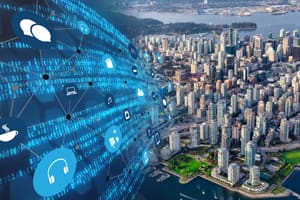Smart Cities Rely on Smart Infrastructure to Make People’s Lives Better
Smart Cities help urban environments to develop and grow by using modern technology, including data-driven solutions, that provide a sustainable, resilient, equitable, and privacy-respecting community for its inhabitants.
NOTE: The views expressed here are solely those of the author and/or interview subject and do not represent positions of IEEE. Some references may require subscription to access content.
 According to a United Nations (UN) report, by 2030, the world will see 43 megacities with more than 10 million inhabitants each, up from approximately 31 megacities as of 2018. By 2050, the UN projects that more than 60% of the world’s population will reside in urban environments, many in developing countries. With this push toward urban environments, cities are being stressed like never before. In addition to aging infrastructure, cities are experiencing increased demand on energy, water, transportation, and other resources.
According to a United Nations (UN) report, by 2030, the world will see 43 megacities with more than 10 million inhabitants each, up from approximately 31 megacities as of 2018. By 2050, the UN projects that more than 60% of the world’s population will reside in urban environments, many in developing countries. With this push toward urban environments, cities are being stressed like never before. In addition to aging infrastructure, cities are experiencing increased demand on energy, water, transportation, and other resources.
Smart Cities is the concept of helping urban environments to develop and grow using modern technology to address many of these issues to provide a sustainable, resilient, equitable, and privacy-respecting community for the inhabitants. These cities utilize advanced technologies and data-driven solutions to improve the quality of life for residents. By leveraging the power of IoT (Internet of Things) and ICT (information and communications technologies), the cities can utilize sensors to manage their assets and infrastructure, collect and analyze data, and engage with citizens in real time. They optimize resource consumption, transportation, energy management, waste management, and much more. Ultimately, the Smart City has the ability to create an environment that is efficient, safe, and responsive to the needs of its residents.
Smart Cities rely on data collected by what is often referred to as smart or intelligent infrastructure. Sensors applied throughout the city—in its transportation, energy, and water systems, for example—aid the city in making decisions about traffic patterns, resource development, and building plans.
Smart grids are utilized to efficiently manage energy distribution within these environments. IEEE Standards for Smart Energy Profile Application Protocol, as published in IEEE 2030.5(™)-2018, enables utility management, including demand response, load control, and management of distributed generation[1]. IEEE also offers IEEE Smart Grid Research to aid in smart grid–related content.
Dr. Georges Zissis, Professor at Toulouse III University (France), IEEE Senior member, and chair of the IEEE Smart Cities Technical Community, has published many articles on smart lighting systems, which many of these cities are using. He describes a Smart City as “a complex cross-discipline object that brings together cutting-edge technology and human society. The data is the connection between the technology and the people. The objective of the Smart City is to optimize the service that the city can provide to its citizens. In order to do that, we need to understand the behavior of the citizens themselves.”
Dr. Zissis explains the challenge in understanding these behaviors because humans are naturally unpredictable. Outside influences also may contribute to that unpredictability. “Using sensors, we can collect a lot of data—environmental things like temperature, sunlight quantity, air quality, water levels, and so on. Considering the population movements and taking into account the behaviors of individuals in the city, the idea is to combine and analyze these two large data sets (the environmental data and the population behaviors) to extract patterns from which we can make predictions. This results in offering the right service at the moment that the public needs it.”
Dr. Sayani Sarkar, an expert in drone technology and a member of the IEEE Young Professionals Climate and Sustainability Task Force, is assistant professor of computer science at Bellarmine University (KY, USA). Dr. Sarkar’s research includes using artificial intelligence in sustainable environmental design. She concurs that IoT plays a significant role in enabling efficient resource management for a Smart City. She says, “IoT devices and sensors enable real-time monitoring and data collection from various city systems, enabling efficient resource management and enhancing the overall urban experience.” See Dr. Sarkar’s insights on Smart Cities.
One of the many challenges in this new environment is managing privacy. Collecting data must be done in an anonymous way to protect the public’s privacy while simultaneously providing the right service at the right time. One framework for preserving privacy[2] was presented at the IEEE 6th International Conference on High Performance Computing and Communications. Research is ongoing to develop system designs that can manage the enormous data with appropriate levels of privacy[3].
Examples of Smart Cities according to SustainableReview.com:
|
Another challenge is integrating new intelligent systems into infrastructure that is hundreds or thousands of years old. Both Dr. Zissis and Dr. Sarkar reference the importance of developing smart systems alongside the older built environment. Historical buildings that need to be made more energy efficient must be modernized with new technology without impacting their traditional structures. In the paper “Smart Urbanism in Older Cities,” the author discusses how an old city can evolve to a Smart City by overcoming challenges and still helping citizens maximize their well-being.
The promise of Smart Cities is to harness the power of technology to create a resilient urban environment. By addressing renewable energy adoption, intelligent transportation, efficient waste management, sustainable building practices, water conservation, and citizen engagement, Smart Cities demonstrate how technology can play a role in improving urban environments.
IEEE provides a home for those interested in transforming the urban landscape into cities that are safe, efficient, and happy places for people to live. As Dr. Sarkar points out, “The work I do today has the potential to shape the future. Engineering plays a crucial role in the global challenge of tackling climate change.”
Dr. Zissis goes on to say that IEEE provides the network that allows engineers to learn from one another as well as to exchange ideas that ultimately develop into methods of improving people’s lives.
Dr. Sarkar’s insights on Smart CitiesSmart Cities successfully integrate advanced technologies, such as advanced transportation and waste management, with data-driven solutions to promote environmental sustainability while enhancing the quality of life of citizens. |
[1] “IEEE Standard for Smart Energy Profile Application Protocol,” in IEEE Std 2030.5-2018 (Revision of IEEE Std 2030.5-2013), pp.1-361, 21 Dec. 2018, doi: 10.1109/IEEESTD.2018.8608044.
[2] C. Inibhunu and A. Carolyn McGregor, “A Privacy Preserving Framework for Smart Cities utilising IoT, Smart Buildings and Big Data,” 2020 IEEE 22nd International Conference on High Performance Computing and Communications; IEEE 18th International Conference on Smart City; IEEE 6th International Conference on Data Science and Systems (HPCC/SmartCity/DSS), Yanuca Island, Cuvu, Fiji, 2020, pp. 1096-1103, doi: 10.1109/HPCC-SmartCity-DSS50907.2020.00197.


